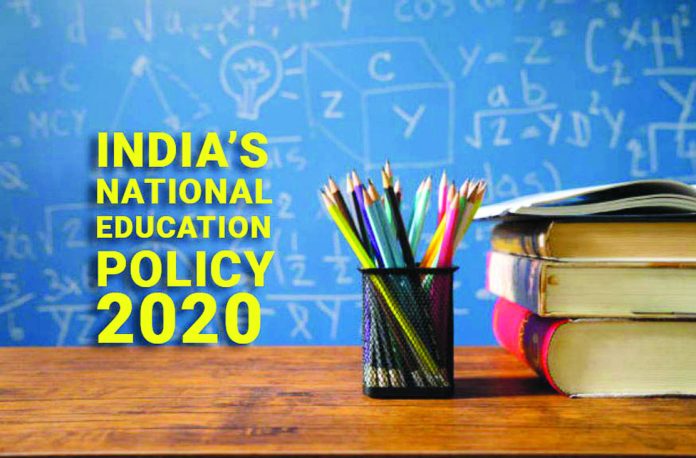Dr Nater Singh
It was on the 29th of July 2020 that the Union Cabinet of India approved the New Education Policy for Schooling and Higher Education (NEP). This new policy aims to replace the old education policy which has been in effect for 34 years since its genesis in 1986, and is said to be based on the four pillars of Assessment, Equity, Quality, and Accountability.
It intends to replace the prior 10+2 system of schooling with a 5+3+3+4 structure. The Government aims to make education more holistic, flexible, and multidisciplinary through this policy. However, as all things do, this New Education Policy also possesses some major advantages and disadvantages when compared to the old system.The National Education Policy (NEP) of 2020 has established a specific objective of introducing skilling and vocational education to 50% of school students by the year 2025, with the intention of extending this exposure to nearly all students by the year 2030.
But NEP2020 have many bottle necks which need immediate attentions. The following hurdles need a thread bearing discussion.
Lack of internet connections
According to the India Internet 2019 Report, 99 percent of internet users in the country utilise mobile phones rather than laptops or PCs to access the internet. In rural areas, laptops and desktops are used by just 2 percent and 1 percent of the population, respectively, whereas in urban areas, laptops and desktops are used by 6 percent and 4 percent of the population, in rural India is still extremely low, at only 27 percent. More than 40 percent of villages have yet to be connected to the internet grid as part of the Bharat Net increased .
Pressure and Competition
for Students:
One of the primary concerns with the policy is the potential increase in pressure and competition among students. NEP emphasizes the importance of standardized examinations and encourages board exams at multiple levels, starting from the early years. This approach may lead to an excessive focus on grades and performance, compromising the overall development and well-being of students
Narrowing of Subject Choices
The new policy proposes a shift towards a multidisciplinary approach, which aims to provide students with a broad range of subjects. However, this might inadvertently limit their options. With an increased emphasis on vocational education and skill development, subjects like arts, humanities, and social sciences may receive less attention. This narrow focus could hinder the overall intellectual and creative growth of students.
Insufficient Teacher Training and Support
The NEP 2020 falls short in adequately addressing the training and support needs of teachers. The lack of clear guidelines for continuous professional development and incentives may impact the quality of education imparted in classrooms.
Imbalance in Digital InfrastructureThe new education policy places significant emphasis on digital education and e-learning platforms. Which can enhance access to education, it also exposes the digital divide prevalent in our society. Not all students have equal access to digital devices, internet connectivity, or resources required for online learning. This imbalance may further marginalize students from economically disadvantaged backgrounds, exacerbating educational inequalities.
Standardize Challenges
The policy’s aim to standardize education across the country may overlook regional and cultural diversities. The one-size-fits-all approach might not cater to the unique needs and aspirations of students from different states and region.
According to ASER (Annual Status Of Education Report) 2023, only 57.3 percent of students demonstrate proficiency in reading sentences in English, with nearly three-quarters of them unable to comprehend the meaning of the text. The deficiency in basic mathematical skills is equally concerning, as demonstrated by the fact that only 39 percent of youth can accurately measure length using a scale when the starting point is not zero. A mere 43.3 percent can successfully solve division problems involving three digits by one digit. These revelations underscore the urgent need for a comprehensive overhaul of the educational framework to ensure a holistic and effective learning experience.
Disparity and Barriers
Compounding the challenges identified in the ASER 2023 is the disconcerting gender gap, particularly among 18-year-olds, reaching an alarming 32.6%. This discrepancy in educational opportunities between genders is not only an affront to the principles of equality but also poses a significant hurdle in achieving a more inclusive and equitable society. Addressing gender disparities in education is crucial to harnessing the full potential of the nation’s human capital.
The ASER 2023 report sheds light on another critical issue – the lack of interest or viable avenues for vocational courses. Merely 5.6 percent of students in the 14-18 age group opt for vocational training or related courses. Recognizing the pivotal role of vocational education in preparing students for practical skills and employability, there is an urgent need to expand and promote vocational training programs, fostering a symbiotic relationship between education and industry needs.
A disconcerting trend highlighted in the report is the pervasive use of phones for entertainment activities among the youth. Nearly 80 percent of students in this age group use their phones primarily for non-educational purposes such as listening to music and watching movies. While technology can be a powerful educational tool, its overuse for entertainment detracts from academic pursuits. It is crucial to instill responsible and educational use of technology among students to harness its potential for enhancing learning outcomes.
(The author is former Principal)


